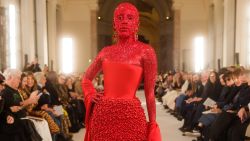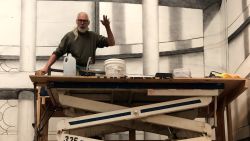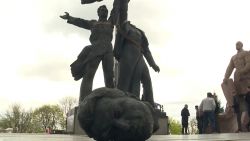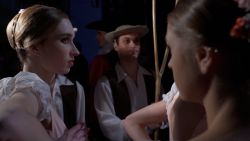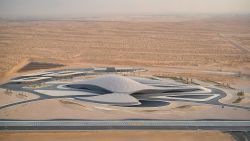Editor’s Note: Philip Tinari is the director of the Ullens Center of Contemporary Art in Beijing. He is also the co-curator of “Art and China after 1989: Theater of the World,” now on view at the Solomon R. Guggenheim Museum in New York.
Zeng Fanzhi is perhaps one of China’s best-known painters. He is also one of its savvy interlocutors and most knowledgeable connoisseurs.
Now, Zeng is offering a unique twist on one of the art world’s most recognizable figures by recreating Van Gogh’s self-portraits in a series of striking new paintings.
The collection of six canvases – three of which are going on display for the first time at Amsterdam’s Van Gogh Museum – see Zeng adding his own signature swirls and expressionist brushstrokes to the Dutch painter’s familiar face.
The exhibition “Zeng Fanzhi | Van Gogh,” pays a special tribute to the revolutionary artist whose museum he now inhabits. Van Gogh’s square format remains, though Zeng updates it with ready-for-Instagram videos showing the paintings taking shape.
It is widely known that Van Gogh drew inspiration from the Japanese art of his time (he used the term “Japonaiserie” in his letters). Now, more than a century later, Zeng returns the favor as the first living Asian artist to show alongside the Van Gogh Museum’s holdings.
A post-Mao painter
Interestingly, the exhibition opens in the same week as the 19th Party Congress in Beijing, where the country’s leadership is expected to convey China’s expanded role in the world.
For Zeng, as for many artists who came of age in the early post-Mao years, the great figures of the Western tradition loom as inspiration. They help him to consider the ways in which art can encourage individual vision, formal experimentation and social commentary.
Renowned Chinese artist recreates Van Gogh self-portraits to stunning effect
In recent years, Zeng has surrounded himself with some of China’s most innovative and influential entrepreneurs, like Jack Ma, Pony Ma, and Thomas Shao. He offers them a sense of transcendence and inspires people to connect the day-to-day bustle of China’s economic growth with the larger truths of history, beauty and thought.
If Zeng feels the internal anxieties that plagued Van Gogh, he doesn’t show it. But if we were to choose paintings that stand in for this particular time and place – China at the dawn of yet another new era – we might do worse than to look to his. They are at once grounded and frenetic, classical and subversive, monumental and ethereal.
A visit to Zeng’s studio in Caochangdi, a neighborhood in Beijing’s northeastern outskirts, is an experience of quick transcendence. Greeted by an ancient wooden bodhisattva, guests are offered hot drinks and ushered into a room of the grand, blocky proportions found throughout the capital’s art districts since the mid-2000s. Strains of Mendelssohn and Tchaikovsky lilt through the air.
Unlike the industrial feel of many Beijing studios, Zeng’s workshop serves as both an active space for producing massive oil paintings and intricate pencil drawings, and as a reflective place for reading, conversation, cigar smoking and even afternoon naps. It is littered with books – mainly on the masters of Western painting from the renaissance onward. It is also impeccably appointed, though he would not want us to dwell on the specifics of the furniture or porcelain.
A painting prodigy
Zeng belongs to a generation that sits on a cusp in Chinese history. Born in 1964, he remembers the Cultural Revolution and the feeling of social control from his childhood. But he was too young to participate fully in the artistic awakening of China’s rollicking 1980s.
Zeng spent that decade at home in the capital of Hubei province, Wuhan, where the city’s art academy accepted eight students to its oil painting department every four years. Having missed his chance the first time around, Zeng spent his early twenties working in a printing press and waiting for another turn.
This diligence, when he did finally enter the Hubei Fine Arts Academy, became legendary: When not painting late into the night, Zeng would absorb what information he could from the school’s limited library. He remembers an encyclopedia of Western art history, published by the Japanese newspaper company Asahi Shimbun, from which he first learned about figures such as Beckmann, Ernst and Schiele.
Zeng Fanzhi: Parcours
Zeng’s earliest works boldly explored internal psychological terrain, attracting the attention of local critics and curators in the rocky years following the Tiananmen protests of 1989. For his graduation project, he rejected the norm of painting peasants or shepherds on China’s rural periphery, and instead created a triptych inspired by a hospital across the street from his student apartment. Arranged into compositions that channeled Western religious paintings, the works oozed with the nervous tension of a painterly prodigy finding his place in a turbulent society.
Within months, Zeng had sold his first painting (to the dealer Johnson Chang). He was then included in the January 1993 exhibition “China’s New Art: Post-1989,” which Chang organized in Hong Kong to bring international attention to the artistic outpouring that had taken place since Tiananmen. Zeng then moved to Beijing, entering the capital’s vibrant art scene and quickly realizing the affectations and pretenses that underlay success within it (his best-known works – the “Mask Series” – date back to this moment of jaded discovery).
Constantly evolving
Zeng’s style has continuously evolved in the quarter-century he has spent in Beijing. And crucially, unlike many of his contemporaries, when he shifts gears, he does so for good.
Last year, I had the privilege of curating Zeng’s largest retrospective to date, a sweeping survey of his career’s output at the Ullens Center for Contemporary Art in Beijing. For the occasion, Zeng’s longtime friend and sparring partner, the renowned Japanese architect Tadao Ando, designed a concept for our space. Through inserting a series of freestanding walls, he transformed the converted factory into into rigidly structured “parcours” (also the exhibition’s title) that took visitors through Zeng’s life and work.
The exhibition featured a 13-by-13-foot painting – featuring his signature brushwork and palette – that revolved around elements from Renaissance masters such as Dürer and Da Vinci. Beside it, one of a series of eight openings through which Zeng’s 2009 self-portrait remained visible at the far end of the space.
Through curating the exhibition, I learned a great deal about Zeng and, most importantly, the level of detail that goes into his creative process. Zeng meticulously records this process by filming his every stroke. When paintings are as layered as his, each canvas contains hundreds of iterations that are altered and buried as the act of painting unfolds.
“Zeng Fanzhi | Van Gogh” is on at The Van Gogh Museum in Amsterdam from October 20, 2017 to February 25, 2018.


